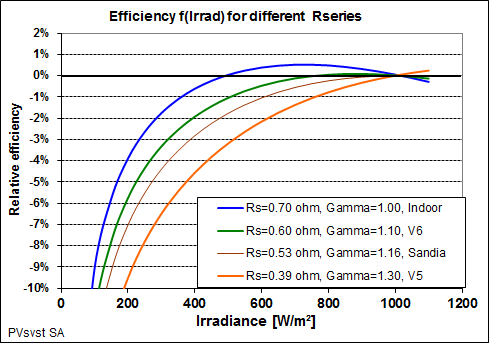|
<< Click to Display Table of Contents >> PV module - R series determination history |
  
|
|
<< Click to Display Table of Contents >> PV module - R series determination history |
  
|
The Serie Resistance is one of the 5 unknown related (coupled) parameters when adjusting the one-diode model. It cannot be determined from the datasheets, so that we have to do hypothesis about its value.
The Rserie has a high impact on the Low-light relative efficiency. So that we may use this measurement for fixing it accurately.
There is a linear correlation between the Rserie and the Diode Ideality factor (Gamma). .
With the PVsyst, version 5: the default was based on the diode ideality factor, fixed at 1.30 for mono, and 1.35 for poly crystalline modules, according to our outdoor long-term measurements. However this lead to very bad low-light performance, and the PVsyst simulation was known for underestimating the PV yield.
With the version 6, up to V6.25 : on the basis of Sandia Laboratories outdoor measurements of about 100 PV modules, we updated the fixed diode ideality factor, at 1.05 for mono, and 1.10 for poly crystalline modules, improving the low-light performance.
Since version 6.26 (July 2014), for crystalline modules, we observed from many measurements of independent laboratories that the low-light relative efficiency at 200 W/m2 is rather stable, around -3% with respect to STC. This is now the default for modules without an explicit definition of the Rserie (and eventually Rshunt) parameters. In this way the low-light performances of the PV modules - as proposed by default - are close to the reality.
The idea is to have a "worst case" default value for modules without an explicit measurement. So that when including new PV modules in the database, the performances are equivalent for all modules without specific measurements. The value may be improved if the manufacturer provides an independent measurement with better characteristics.
However some new technologies aiming to high efficiencies tend to diminish the Rserie, in order to improve the STC performance. However this doesn't involve a significant gain at low irradiance as the ohmic loss goes with the square of the current; so that the low-light relative performance may be below -3%. This may be the case namely for Twin Half-cut cells PV modules, where the current in each sub-module is divided by 2.

Therefore a Gamma default value is proposed in PVsyst for each technology:
a-SI:H Gamma = 1.4
a-SI:H tandem Gamma = 2.8
a-SI:H tripple Gamma = 4.2 (measured)
CdTe Gamma = 1.5 (unknown)
CIS Gamma = 1.5 (measured)
AsGa Gamma = 1.3 (unknown)
As these values are not well established, they can be modified by the User in the "Hidden Parameter" facility.